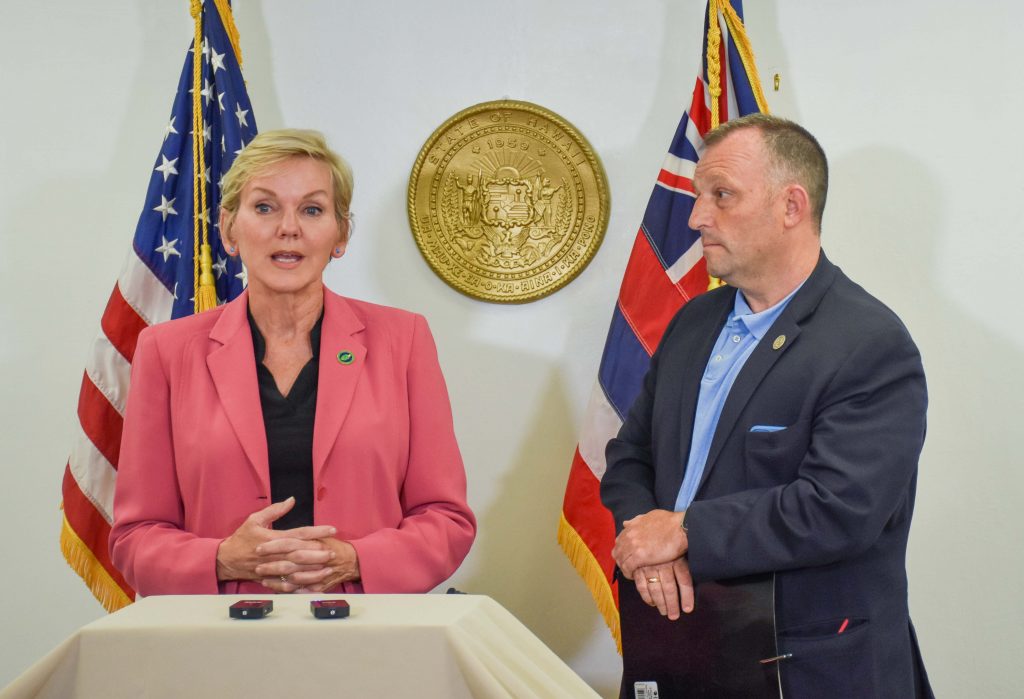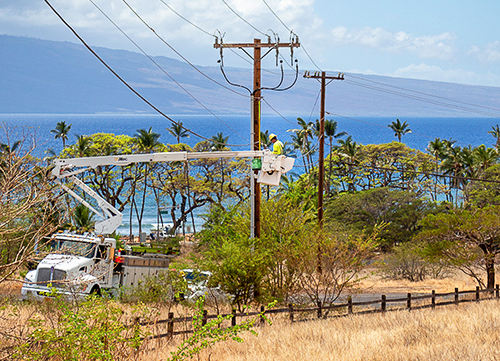US Energy Secretary tours Lahaina, pledging federal help to improve electric infrastructure, become more resilient

US Secretary of Energy Jennifer M. Granholm toured the devastation of Lahaina Town on Monday and said she couldn’t help but notice all the wooden utility poles.
“It’s not good,” she said during a press conference in Wailuku with Hawai’i Gov. Josh Green by her side. “You got to have steel reinforced poles if you are having above ground wires.”
And even better, she said, is to have underground wires, although replacing existing above ground wires would be expensive, thus requiring strategic selection of the key transmission lines to upgrade.
Granholm also said the Lahaina substation, now in the middle of the seaside town, has “got to be moved and pushed back.”
Hawaiian Electric plans to address these type of improvements to its existing infrastructure in its proposed $190 million, five-year Climate Adaptation Transmission and Distribution Resilience Program — which currently is awaiting approval from the state Public Utilities Commission.
Granholm came to Maui, at the request of President Joe Biden, to offer federal help for energy recovery from the fires and to tout the US Department of Energy’s $95 million grant to Hawaiian Electric to fund half of its resiliency program. The grant was announced on Aug. 30 by the White House.
“But we canʻt spend the money until [the utility commission] says okay,” said Alan Yonan, a spokesperson for Hawaiian Electric. “Funding is contingent on PUC approving the program. Weʻre waiting.”

The 504-page application for the program was submitted to the utility commission in June 2022, more than a year ago — and before three wildfires broke out on Maui on Aug. 8, 2023, with the fast-moving blaze in Lahaina killing at least 115 people.
The proposed program includes wildfire mitigation by hardening infrastructure and increasing situational awareness and control — which includes cameras, sensors and reclosers — that are targeted to areas prone to wildfire.
“We’d be doing cartwheels if it got approved,” Yonan said.
Hawaiian Electric said in a news release that it had applied in April 2023 for this federal grid resilience funding through the Bipartisan Infrastructure Law. The $95 million grant was announced nine days after Biden visited Lahaina to see the destruction for himself and pledged to help Maui recover and rebuild.
This is in addition to another $6 million grant Hawaiʻi received in June for building back a more resilient grid with funding from the same law, Granholm said.
While some of the $95 million in federal funding will help Maui, Hawaiian Electric also will spend large portions of it on projects on O’ahu, the Big Island, Molokaʻi and Lānaʻi.
Hawaiian Electric is a for-profit, investor-owned, publicly traded utility that serves approximately 95% of Hawai‘i’s population and operates approximately 9,400 miles of transmission. (It does not serve Kauaʻi, which gets its electricity from the Kauaʻi Island Utility Cooperative.)
Green said the funding “really helps because our grid is wounded. Our concerns remain about wires and how we deal with gale force winds on top of dry climate on top of so many challenges.”
On Aug. 25, Maui County sued Hawaiian Electric, claiming the utility company failed to shut off power during exceptionally high winds and dry conditions. The lawsuit also said the massive destruction in Lahaina and Upcountry (in which 19 homes were destroyed in Kula) could have been avoided.
The lawsuit said Hawaiian Electric failed “to properly maintain and repair the electric transmission lines, and other equipment including utility poles associated with their transmission of electricity, and to keep vegetation properly trimmed and maintained so as to prevent contact with overhead power lines and other electric equipment.”

Hawaiian Electric countered on Aug. 28, saying in its own press release that it had de-energized its power lines in West Maui for more than six hours before the deadly afternoon Lahaina fire. The company admits the first Lahaina fire in the morning of Aug. 8 was likely caused by its power lines, but it said the source of the second fire that occurred in the afternoon “has not been determined.”
After seeing the destruction in Lahaina, Granholm said rebuilding the grid needs to be done quickly “for people to get back,” and it should include mitigation efforts against future fires that include removing vegetative fuel sources and adding technology to be able to monitor where trouble spots are to make sure the community is safe.
“In addition to the recovery, we have to look to the future as well,” Granholm said. “And when the community is ready for that, we want to be a partner on the energy side.”
She said a clean energy future is “clear and away” a best practice for communities, especially island communities.
“You have all of the makings to be a 100% renewable energy state,” Granholm said, rattling off Hawaiʻi’s abundance of sun, geothermal energy, onshore wind and yet to be tapped offshore wind.
Hawaiian Electric has been criticized by some for using resources to invest in clean energy at the expense of maintaining and upgrading its existing infrastructure and doing wildfire mitigation.
“I think you have to do both,” Granholm said. “You have to make sure your existing infrastructure works to deliver power to people. But honestly, moving toward clean energy is a resilient move.”
Green agreed: “Our planet is in trouble. You see fires right now in Canada, in Greece, in the western United States, and the catastrophic fire in Hawaiʻi. It’s not a coincidence. I know some people like to minimize the affect of climate change as part of this discussion, but we only had six fire emergencies in Hawaiʻi between 1953 and 2003 and then we had six in the first 15 days of August. I mean this is happening, we are in the middle of it right now.”
On Aug. 8, major Hurricane Dora and its low-pressure system were passing to the south, combined with a high pressure zone to the north, which created a large pressure gradient that caused dry air and swirling strong winds upwards of 70 mph.
It is not known currently how big a role, if any, climate change played in the Aug. 8 fires, which included three on Maui and four also happening on the same day on the Big Island, stretching fire fighters thin. Scientists are studying this now.
“I’m saying climate change is there, but if you are going to blame climate change on this I think you ought to wait until the study comes [out],” said Speaker of the House Kevin McCarthy during his bipartisan Congressional trip to Maui last week. “Because a lot of people lost their lives that probably wouldn’t had to if we had a different mitigation how we treated a lot of different areas.”
He agreed with Granholm and Green on many of the mitigation and infrastructure improvements of putting wires underground and removing hazardous vegetation that serves as fuel. McCarthy said building back should include stronger building codes, like he saw in Florida after devastating hurricanes.
But McCarthy stopped short of advocating for green energy for the future, saying extreme weather has always been around.
“I think there are disasters that are going to continue to be disasters,” he said. “I think we can better prepare where a disaster [such as a wildfire] doesn’t happen.”
But Green said if “the world wants to be serious about stopping” catastrophic extreme weather events, “we all have to come together and actually deal with climate change.”
Granholm said she also is offering the technical assistance of the federal government. There are 17 national laboratories, with the natural renewable energy laboratory leading an effort of a consortium of seven labs “to help communities, when asked, plan for building back better in the wake of emergencies … or because they want to get to a clean energy future.”
She pointed out that Puerto Rico has been getting assistance through labs after going through catastrophic hurricanes that destroyed infrastructure.
Granholm said one resiliency solution is micro-grids, a self-sufficient energy system that serves a discrete geographic footprint, such as a hospital complex. Green said Hawaiʻi has established a micro-grid around an airport, “which can be the lifeblood in a recovery.”
These micro-grids can connect and disconnect to the grid to protect other parts of the grid.
Early estimates put the price tag of Lahaina’s recovery and rebuilding at about $6 billion, with lawmakers agreeing that more protective measures should be part of rebuilding the grid.
“We are going to take on the best of recommendations,” Green said. “Like as was mentioned, there are labs doing new things on energy for us that will help going forward. They have such expertise that we will avail ourselves of that.”
Granholm said there is about $20 billion in the Bipartisan Infrastructure Law earmarked for resiliency. Green joked he wants $2 billion of it.
But since he knows a “smaller state” won’t get that much, he said “we can take it upon ourselves to have the world help us.”
He pushed again for a $50 green fee charged to tourists, many international, that he says would generate about $400 million a year. The measure didn’t make it through the State Legislature earlier this year, but he said his administration would push for it again.
“We all have to look to this clean energy future to diminish the likelihood of more of these extreme weather events because of climate change,” Granholm said. “We better do our part, and get other nations to do their part. The president is over at the G20 [Summit in New Delhi] getting them to commit to 3 times as much renewable power by 2030 as what currently exists.
“Everyone is pushing in this direction because the United States is not alone, Hawaiʻi is not alone, in seeing the affects of these extreme weather events that’s happening everywhere.”
She also said moving to clean energy helps economies by creating jobs and it reduces the expense of energy for individual households.
In the meantime, the $95 million in federal funding for Hawaiian Electric, if the program is approved by PUC, would be used for the following in its service areas:
- Replacing poles and conductors on high-priority transmission lines, including two on Maui
- Hardening circuits that serving critical customers such as hospitals, public infrastructure and defense facilities
- Replacing critical poles that support multiple circuits with fire-resistant materials
- Doing wildfire mitigation by hardening infrastructure and increased situational awareness and control (e.g., cameras, sensors and reclosers) targeted to areas prone to wildfire
- Putting underground portions of certain distribution circuits
- The complete removal of off-right-of-way hazardous trees that are weak, dead, diseased or structurally compromised and pose a risk to power lines (as opposed to trimming)
- Relocating and elevating the Maui control center to avoid flooding and developing a backup control center on O’ahu








